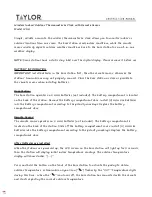
IM 1234-1 • BACNET THERMOSTAT 28 www.DaikinApplied.com
s
equenCes
of
o
peraTIon
PID Control Loops
A PID control loop calculates an error value from the difference
between the measured room temperature and the active
setpoint. The error value is expressed as a percentage and
is typically used in a BAS controller to control the state of an
output. When the difference between the setpoint and room
temperature is large, the error is large. As the system reduces
the difference between the setpoint and space temperature,
the error becomes smaller. In a simple example, if the output
of the PID loop that is controlling a modulating valve is 50%
the valve would be opened half way; if the output of the loop is
100% the valve position is fully open.
The BACnet Thermostat heating and cooling PID loops are
implemented in all models.
The BACnet Thermostat uses a PID loop for the discharge
air temperature. The discharge air loop controls the position
of the economizer. For this loop the setpoint is the measured
temperature of the air that is discharged by a roof top or heat
pump unit.
The PID loops in the BACnet Thermostat are standard BACnet
objects.
Valve Operation for Fan Coil Units
Hot and chilled water valves are used for heating and cooling
in the fan coil unit version of the BACnet Thermostat. The
two-pipe programming includes a method to determine supply
water temperature.
ON/OFF Valves
On a call for cooling or heating, the valve will open once the
loop controlling the valve has reached 50%. The valve will
close once the loop has fallen to 5%.
•
Normal
– The valve is closed when the output is inactive
and open when the output is active
•
Reverse
– The valve is closed when the output is active
and open when the output is inactive
Modulating Valves
On a call for cooling or heating, a modulating valve will
modulate from 0 to 100% over the first half (0 to 50%) of the
PID loop output controlling the valve. The BACnet Thermostat
supports both normal and reverse action which can be set from
the user interface.
•
Normal
– The valve is fully closed when the output signal
is 0 volts and fully open when the output is 10 volts DC
•
Reverse
– The valve is fully closed when the output signal
is 10 volts and fully open when the output is 0 volts DC
Two-Pipe Water Supply Temperature
Evaluation
For two-pipe fan coil units, the BACnet Thermostat uses the
water supply temperature sensor, input WST, to determine if
chilled or hot water is being supplied to the unit. The water type
is determined by comparing the value of the water temperature
sensor input to the room temperature. The BACnet Thermostat
programming then determines that the water temperature is
one of the following.
•
Chilled
– the water temperature is 10°F below room
temperature
•
Hot
– the water temperature is 10°F above room
temperature
•
None
– the water temperature is within 7°F of room
temperature
If the water temperature is evaluated as None, the BACnet
Thermostat runs the water evaluation program every six hours.
During a water evaluation, the BACnet Thermostat opens
the valve until a water type is determined or for five minutes,
whichever is reached first. If a water evaluation is not being
performed, the valve remains closed.
The supply water type is stored in multistate variable
Water
Available
.
Fan Operation for Fan Coil Units
The BACnet Thermostat has two parts to fan operation.
• Automatic fan control can be controlled from the user
interface by a user with Password 1
• Fan speed is set up during commissioning by a user with
Password 2
Automatic Fan Control
A user with Password 1 can set the BACnet Thermostat
controlled fan to either run continuously or to start
automatically on a call for cooling or heating.
Auto
– When Auto is selected, the fan runs only when there is
a call for cooling or heating. It continues to run after the call for
cooling or heating for the period set by the fan delay timer.
ON
– The fan will run continuously regardless of the heat/cool
modes or occupied state.
Low, Medium, High
– For systems with three-speed fans,
the user has the choice of low, medium or high speed as the
continuous running speed.
















































